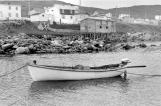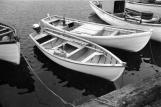14
Some time during the first or second decade of the twentieth century one-cylinder, gasoline engines became available to fishermen of Winterton as they did elsewhere in North America. The coming of the make-and-break engine led to major changes in boat design. The stern assembly was changed to accommodate the engine shaft and propeller as well as provide more bearing aft (at the stern), for the extra weight of the engine itself. The over-hung transom stern was designed using a new arrangement of knees.Before engine power, inshore fishing boats were kept small because they had to be rowed to and from the fishing grounds. Powered by engines, boats could be made longer, wider and deeper. Fishermen could fish further from shore and boats could carry more fish. At this time we see the development of larger trap skiffs, able to carry more fish and handle larger traps, and other motorboats used for trawling further out on the edge (the area where the bottom changed from shallower rocky ground to deeper muddy or sandy ground), in greater depths of water. The increased speed and further distances also led to changes in the bow design. As engines improved and horsepower increased more flare was needed at the bow of open boats to throw away the spray from oncoming waves when steaming to windward.
15
A 16' 4" rodney or punt with an outboard motor installed. Built by Marcus French.August 1979
Winterton, Newfoundland, Canada
 Credits:
Credits:photo by David A Taylor
16
A later engine design, the gasoline outboard motor, influenced boat design to an even greater extent, especially the design of the earlier punts. The early punts had small, high counters slanted outward in relationship to the keel. These were not suitable for mounting outboard motors. In order for the propeller to reach far enough into the water the counter would have to be cut down severely making the punt less seaworthy. Builders began to design wider counters that were mounted with very little rise above the keel and in a very upright direction. This led in turn to a wider boat at the stern with a straighter and flatter hull bottom that had little rise at the back. The adjustments allowed the hull to better accommodate speed. Many of the older fishermen/builders did not accept the change, claiming that the speedboats were not as seaworthy as the earlier punts.17
Punt and motorboats tied up at the wharfMay 1979
Winterton, Newfoundland, Canada
 Credits:
Credits:photo by David A Taylor
18
When new innovations were made in fishing technology with the introduction of the cod trap, changes were also made to the design of fishing boats. These changes to the shape of the hull were made so that the boats could deal with the heavy weight of the cod trap and to create a greater carrying capacity. These trap skiffs, were around 20 to 30 feet in length with a corresponding increase in beam and depth.At this point, it is likely that early moulds, used to build larger punts, were adjusted proportionately to accommodate the need for increased boat size. Many of the seaworthy characteristics of the basic hull would have been retained.